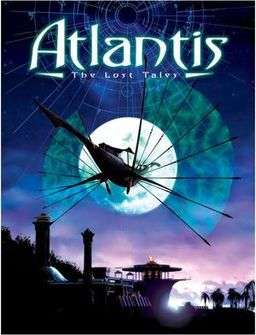Atlantis: The Lost Tales
| Atlantis: The Lost Tales | |
|---|---|
|
Cover art | |
| Developer(s) | Cryo Interactive |
| Publisher(s) | DreamCatcher Interactive |
| Director(s) | Rémi Herbulot |
| Producer(s) | Rémi Herbulot, Jean-Martial Lefranc, Philippe Ulrich |
| Designer(s) | Johan Robson |
| Programmer(s) | Éric Safar |
| Artist(s) | Thomas Boulard |
| Writer(s) | Johan Robson |
| Composer(s) | Pierre Estève, Stéphane Picq |
| Engine |
Spherical-VR OMNI 3D |
| Platform(s) |
Microsoft Windows DOS Sega Saturn PlayStation |
| Release date(s) |
PC‹See Tfd›
‹See Tfd›
Sega Saturn‹See Tfd›
PlayStation‹See Tfd›
|
| Genre(s) | Adventure |
| Mode(s) | Single-player |
Atlantis: The Lost Tales is a fantasy adventure computer game developed by Cryo Interactive and published by DreamCatcher Interactive, and released on September 30, 1997. The game is named after its initial and most important setting, Atlantis. It is the first in a Myst-like series, and is followed by Atlantis II (Beyond Atlantis outside Europe), Atlantis III: The New World (Beyond Atlantis II), Atlantis Evolution and The Secrets of Atlantis: The Sacred Legacy.
Plot
The game begins with Seth, the protagonist, joining the Queen's Companions, the personal guardians of the Queen of Atlantis. He discovers after he arrives that the Queen disappeared shortly before he joined. As the story progresses, Seth learns that a power struggle is taking place between the Queen and the Guards of the Consul. The leader of the Guards, Creon, wishes to supplant Ammu, the goddess of the moon, as the most worshiped of Atlantis' gods, replacing her with Sa'at, the sun god; he then wants to conquer the world in the name of Sa'at, using a new weapon that he has developed.
The weapon is revealed to be half of a crystal that is capable of granting immense knowledge to its holder. Long ago, the crystal was split into Light and Dark halves, and the halves were hidden in Easter Island and Stonehenge, respectively. Creon found the Dark Crystal, which has a side effect of driving its holder mad.
Seth retrieves the Light crystal from Easter Island, then returns to Atlantis to face Creon. After Creon's defeat, the weapon he built causes a volcano on Atlantis to erupt. Seth and a few survivors are seen sailing away from Atlantis as it is destroyed by the volcano.
Gameplay
Atlantis is a first-person perspective puzzle game. The entire game is in 3-D. The HUD is basically a 'window' into the world of Atlantis, instead of moving a mouse around the screen, moving the mouse actually moves the screen itself. To interact with the world, the player must position the item, NPC or thing into the middle of the screen. Some critics have found this annoying,[1] as there is no crosshair in the middle of the screen. This means the player must guess where the centre is, and move the screen accordingly. This has since been fixed in Beyond Atlantis and Beyond Atlantis II, where a crosshair is apparent.
Progression through the game involves solving various puzzles of varying difficulty. Some puzzles are extremely abstract and the solution is completely unexpected, whereas other puzzles are very simple. Another feature of Atlantis is having periods where the player must react quickly to certain events happening in the game. For example, in one section guards chase the player away from a certain area. If the player hesitates in moving backwards and looking for shelter, then the player will lose and will have to restart from the beginning of the scene. This can also be frustrating, as there is only one particular path the player may take, and taking any other part results in capture, death and restarting.
The Saturn version of the game supports the Saturn mouse, despite the fact that it was only released in Europe, whereas the Saturn mouse was only released in North America and Japan. European Saturns can be used with imported peripherals. The PlayStation version lacks the movement clips found in the other versions.
Engine
The game features a number of proprietary technologies developed by Cryo. One such technology is called OMNI 3D which provides a smooth, panoramic 360-degree first-person view of the game environment. Unfortunately, this view tends to be less crisp looking than the movement clips that are pre-rendered in the game. All the character animations are motion captured and feature another technology called OMNI SYNC to ensure proper lip synchronization with audio speech.
Soundtrack
The soundtrack for Atlantis: The Lost Tales was composed by Pierre Estève & Stéphane Picq of Shooting Star and was released in 1998 as a two-CD set (one of which being an enhanced CD containing wallpapers) on the Shooting Star label.[2]
Reception
PlayStation Power gave the game a 52% rating, specifically finding that the game was marred by extended loading times.[3] Adventure Lantern gave the game 86 out 100 score largely due to the intriguing story, pleasant atmosphere and the fascinating locations.[4]
References
- ↑ "Atlantis Review". Quandary/Quandaryland. Archived from the original on 2006-04-02.
- ↑ "Stéphane Picq personal site (CDs section)". Archived from the original on 2011-10-01.
- ↑ PlayStation Power #33 (December 1998), p. 113
- ↑ "Archived copy". Archived from the original on 2016-03-04. Retrieved 2015-05-18.
External links
- Atlantis: The Lost Tales at MobyGames
- Atlantis Review of Gameplay and Engine, Adventure Classic Gaming
- Dreamcatcher games
